Japan
Wood Products Prices
Dollar Exchange Rates of 25th
Feb
2024
Japan Yen 150.49
Reports From Japan
Most
companies ready to raise wages
Most major Japanese companies have agreed to fully meet
their labour union wage demands in this year's spring
wage negotiations to bring relief to workers amid inflation
and retain workers in the tight labour market.
The quick responses were possible partly to strong
corporate earnings, the labour shortage is another factor. A
survey of corporate views on wage trends by a domestic
research group indicated the share of companies that
expect pay to improve was the highest since polling began
in 2006. The most commonly cited reason among these
respondents was securing and retaining workers.
While the momentum for wage increases is picking up
at
large companies the question remains whether the same
will happen among the small and midsize enterprises that
employ around 70% of Japan's workforce.
Japanese businesses as a whole raised pay by 3.6% in last
year's spring wage negotiations but those enterprises with
300 or fewer union members lagged behind at 3.2%
according to the Japanese Trade Union Confederation.
It has been estimated by the government that, to create real
wage growth, it will require wage increases of around 4%
by large companies and in the high 3-4% range in smaller
businesses.
As household struggle with rising costs some full-time
employees in Japan are turning to side jobs to increase
their annual income in response to the effective wage drop
due to price hikes and rising social insurance premiums.
See:
https://asia.nikkei.com/Business/Business-trends/More-Japan-business-leaders-expect-5-wage-hikes-in-2024-poll
Processing machinery orders on the rise
The total value of machinery orders received by the 280
manufacturers operating in Japan and included in the
survey increased by 10.3% in December from the previous
month. In the third quarter 2023 orders increased by
almost 1% compared with the previous quarter.
In the 2024 January-March period the total value of
machinery orders was forecast to increase by 0.8% and
private-sector orders, excluding volatile ones, were
forecast to rise by 4.6% from the previous quarter.
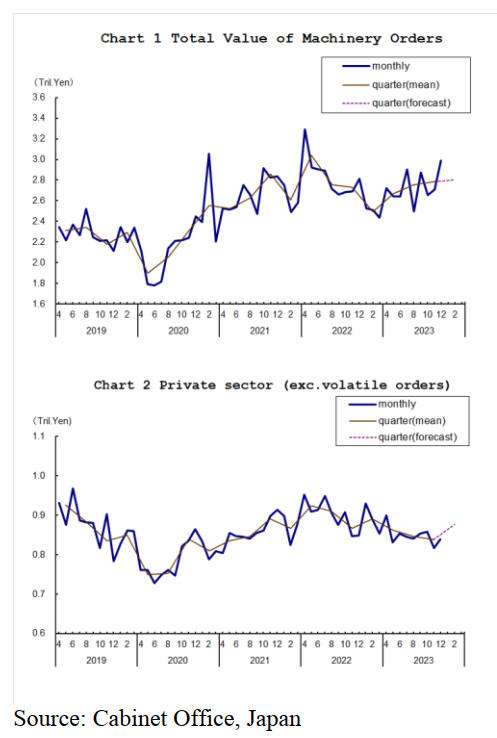
Economists confident negative rates will end
this year
Many analysts are convinced 2024 will be the year the
Bank of Japan (BoJ) ‘normalises’ policy and raises interest
rates above zero. Negative interest rates have been the
corner stone of Japanese monetary policy since 2016 with
the BoJ maintaining ultra-easy policy to conquer deflation.
However, with inflation having exceeded the BoJ 2%
target for over a year and the anticipated wage increases,
economists are confident of an end to negative rates this
year.
In its policy meeting on 23 January the BoJ maintained its
policy pointing to “extremely high levels of uncertainties”
but there were hints that conditions for a policy change
were falling into place.
Japan’s GDP contracted at an annualised rate of 0.4% in
the December quarter which, following the previous
quarter’s revised 3.3% decrease meaning Japan fell into
recession. Both private consumption and capital
expenditure declined in the December quarter, although
exports rose.
The Cabinet Office report also showed Japan losing its
third-placed global economic ranking to Germany. Japan’s
nominal GDP stood at $4.21 trillion in 2023, below
Germany’s $4.46 trillion, with a weak yen contributing to
the decline.
See:
https://thediplomat.com/2024/02/the-bank-of-japans-year-of-living-dangerously/
In February and for the first time in three months the
government downgraded its view on the economy citing
weak consumer spending. With private consumption
contributing around 60% to GDP, the road out of the
current recession will be long. Hopes are high that the
wage hikes promised by companies will drive a recovery
to give the Bank of Japan the opportunity exit its ultra-
easy policy this year.
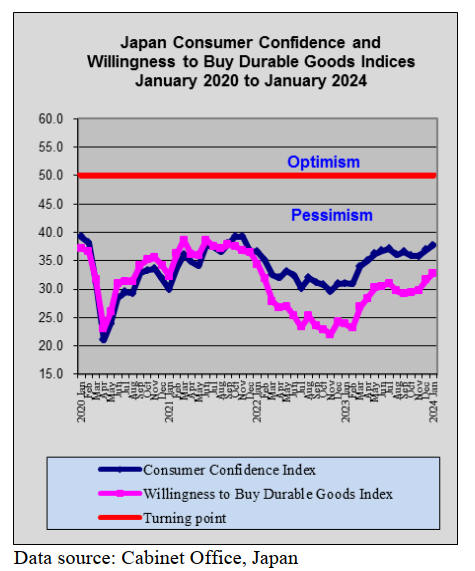
2023 real estate price index trended higher
The Ministry of Land, Infrastructure, Transport and
Tourism publishes a property price index every month
calculated from information from approximately 300,000
real estate transaction prices.
The 2023 Japan’s real estate price index was on an upward
trend for both residential and commercial land and it is
anticipated that the upward trend will continue in 2024 due
to the rising cost of building materials and the inflow of
investment from foreign investors.
See:
https://www.realestate-tokyo.com/news/market-trends-japan-2023/
The real estate price index can be found at:
https://www.land.mlit.go.jp/webland_english/servlet/MainServlet
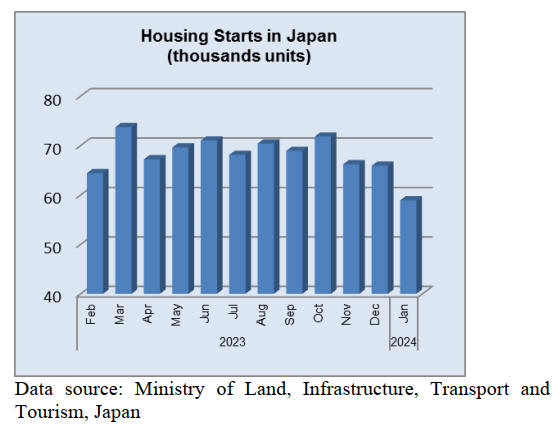
Yen likely to slip to 154 against the US dollar
On 27 February a writer for the Nikkei Asia suggested the
yen looks likely to continue to depreciate against the US
dollar and this has more to do with technical indicators
rather than the overselling that was the main driver during
other periods of weakness.
In February the Japanese currency was at the low 150
range against the dollar where it has remained for about 7
days. This marks a third consecutive year in which the yen
has crossed the 150 threshold. It did so in October 2022
and in early October 2023. A senior currency strategist at
Daiwa Securities sees the yen potentially falling as far as
154 against the dollar.
See:
https://asia.nikkei.com/Business/Markets/Currencies/Yen-seen-sliding-as-far-as-154-to-dollar-as-charts-show-steady-selling
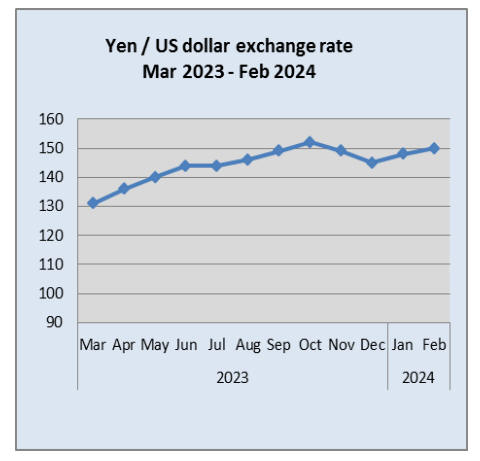
Import update
Assembled wooden flooring imports
The value of Japan’s December 2023 imports of
assembled flooring (HS441871-79) rose around 8% from a
month earlier and year on year the value of imports was up
47%. It should be borne in mind that the Yen/US$
exchange rate in early 2022 was around 120/US$ since
then the yen has weakened considerably to around 145-
150/US$ and this weakness has driven up the cost of
imports.
In December 2023 the main category of assembled
flooring imports was HS441875 accounting for around
67% of the total value of assembled flooring imports. The
second largest category in terms of value was HS441873
exceeding that of HS 441875.
The main shippers of HS441875 in December were China
52%, up from slightly from a month earlier, Malaysia
(12% cf. 8% in November), and Vietnam 10% with a
further 7.5% being shipped from Italy.
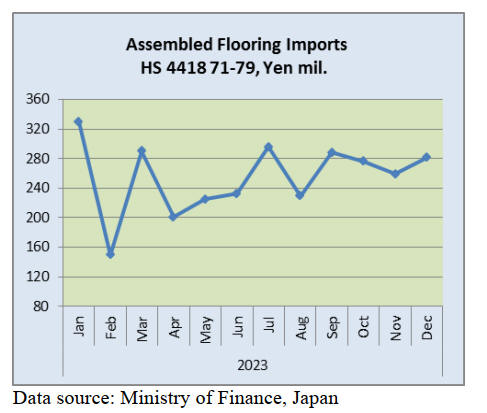
Plywood imports
Building activity slows during the winter months in Japan
and this, along with the New Year holiday’s taken by
construction workers, means consumption of plywood
drops. December plywood imports into Japan were down
12% compared to a month earlier and were also down
(5%) year on year.
The volume of shipments by three of the main suppliers,
Indonesia, Vietnam and China in December were little
changed from a month earlier but shipments from
Malaysia dropped sharply (around 30%).
Of the various categories of plywood imported 86% was
HS441231 in December with HS441233 and HS441234
accounting for around 5% each. The trade data published
by the Ministry of Finance in Japan includes the names of
other exporters of plywood such as Taiwan P.o.C. South
Korea, Gabon and some EU producers but there are no
volumes shown for imports from any shipper other than
the top four mentioned above.
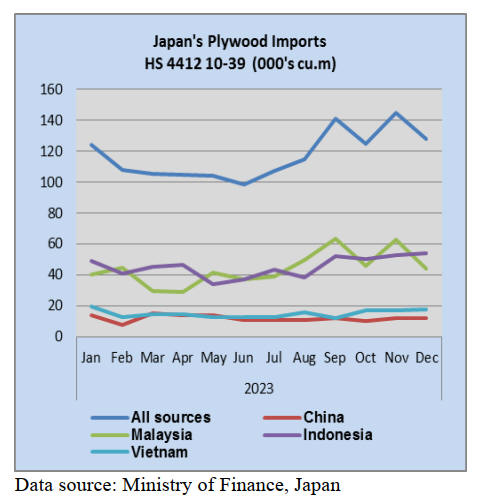
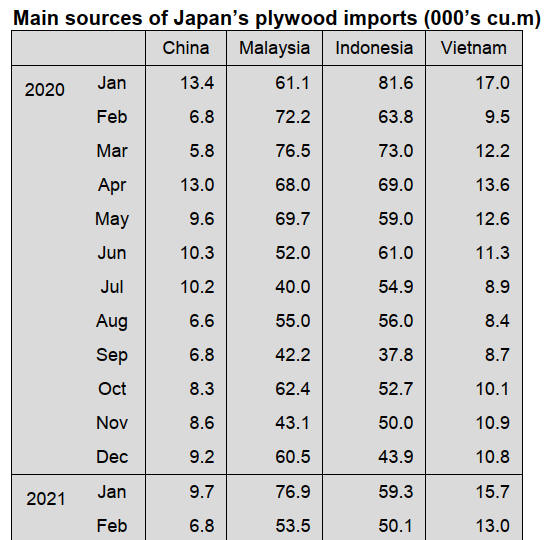 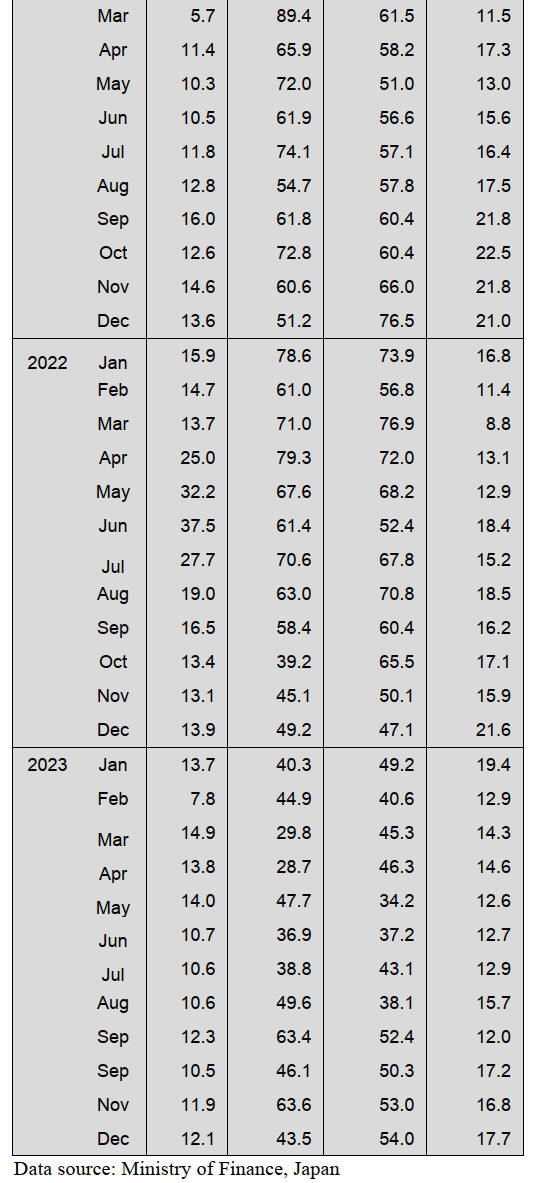
Trade news from the Japan Lumber Reports (JLR)
The Japan Lumber Reports
Trade news from the Japan Lumber Reports (JLR)
The Japan Lumber Reports (JLR), a subscription trade
journal published every two weeks in English, is
generously allowing the ITTO Tropical Timber Market
Report to reproduce news on the Japanese market
precisely as it appears in the JLR.
For the JLR report please see:
https://jfpj.jp/japan_lumber_reports/
Total volume of imports in 2023
Total volume of imported South Sea products, North
American products, Russian products, NZ / Chilean
products and European products is 5,550,000 cbms. The
result is close to the result in 1960, when the new starts
were 5,450,000 units. North American products decrease
20 % from 2022. European products decrease 37 % from
the previous year. A decrease of all imported products is
2,140,000 cbms from 2022. Volume of wooden boards and
laminated structural lumber is 1,280,000 cbms less than
last year. Plywood and laminated structural lumber are
980,000 cbms decreased from the previous year.
In 2023, there was an influence of the third wood shock
and an adjustment was needed for demand and supply.
Since the new starts fell under 820,000 units, demand for
lumber also fell. Especially, the volume of European
lumber and European laminated structural lumber plunged.
Also, the fire at Chugoku Lumber Co., Ltd.’s plant in
August, 2023 influenced the supply for North American
lumber and the demand for North American logs. Volume
of Russian lumber is zero for the first time in seventy
years. NZ logs are popular for China and the price of NZ
logs is high so demand for NZ logs is less than domestic
logs. Imported plywood is under 2,000,000 cbms. MDF,
particleboards and OSB are 900,000 cbms.
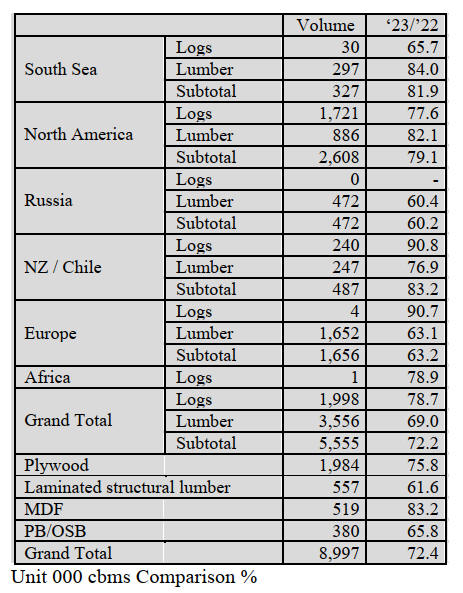
Demand and supply of South Sea logs are balanced
There has been a stable demand for blocks from iron and
steel companies. South Sea logs will arrive to Japan in
February. Movement of South Sea lumber and Chinese
lumber is sluggish.
Once the inquires were lively at the end of the year due to
the strong yen but the inquiries were less as the yen was
weak. Japanese buyers do not buy a lot of lumber.
There was not a huge movement in China and Indonesia
because of the Chinese New Year holiday. Usually,
Chinese or Indonesian sellers lower the price of lumber
positively to get cash before the holiday but this year, a
Chinese manufacturer raised the price of the lumber due to
the increased labor costs and production costs.
South Sea lumber plants struggle with less South Sea logs
but demand for South Sea logs in Japan is low so there is
no problem for supplying.
Structural laminated lumber import in 2023
Total import of structural laminated lumber in 2023 is
557,853 cbms, 38.4 % less than 2022. This is for the first
time in thirteen years to be a level of 500,000 cbms. There
had been too much inventories of imported structural
laminated lumber and lamina for laminated lumber since
summer in 2022 until autumn in 2023. To control the
supply, the contracts were reduced.
Total imports are 37.54 billion yen, 65.2 % down from the
previous year. In 2010, the new starts were 813,126 units
and the new starts in 2023 are 819,623 units, 4.6 % down
from 2022. Imported structural laminated lumber was in a
shortage in 2010 and the price increased.
However, the imported structural laminated lumber in
2023 was overstocking so the price went down. Some
reasons for the decrease in the price were an expansion of
producing domestic laminated cedar post and demand for
beam were changed to Douglas fir lumber.
Volume of medium sized laminated lumber is 28.9 %
down from 2022. Volume of small sized laminated lumber
is 47.2 % less than last year. Volume of pile / beam is 32.5
% down. Demand for whitewood / redwood laminated
post had changed to domestic laminated cedar post.
Imported lumber from Finland is 241,110 cbms, 37.5 %
less than last year. Imported lumber from Romania and
Australia are 45 % less than the previous year.
HS Timber Group had reduced producing laminated
lumber at Radauti plant in Romania after April, 2023 and
it influenced the volume of lumber from Romania. HS
Timber Group got the certification of JAS for laminated
lumber at Kodersdorf plant in Germany in May, 2023.
Then, the volume of lumber from Germany is 1,757 cbms
at the second half of 2023.
Volume of lumber from Estonia is 9 % down and from
Poland is 6.3 % down. The decrease is a small amount.
The average unit price of total imported lumber is 67,301
yen, per cbm. The average unit price of total imported
lumber in 2022 was 119,190 yen, per cbm. In 2020, the
average unit price of total imported lumber was 46,175
yen, per cbm.

North American lumber import in 2023
All kinds of North American logs and lumber decrease by
20 – 30 % from 2022 except hardwood logs.
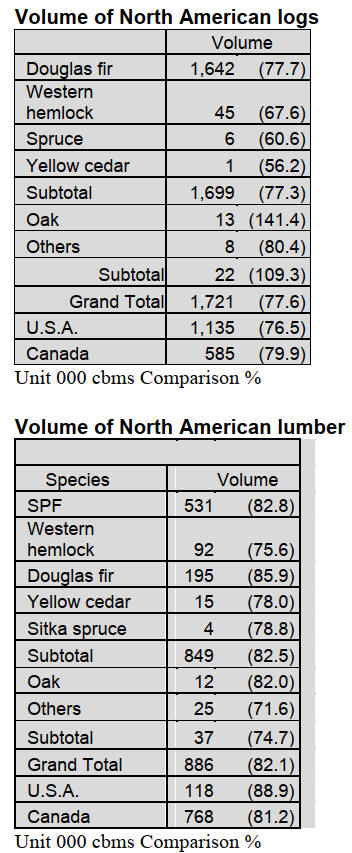
Volume of North American logs is under 2,000,000
cbms
for the first time in three years. A major Japanese Douglas
fir lumber company did not purchase a lot of Douglas fir
logs due to low demand.
The monthly average of arrival volume after
September,
2023 is 107,872 cbms. This is about 30 % less than the
monthly average of arrival volume during January to
August, 2023, which is 151,431 cbms. One of the reasons
for the decrease is that Chugoku Lumber Co., Ltd. stopped
an operation due to the fire occurred at one of its plants at
the end of August. Also, there had been less inquiries for
Doulgas fir logs for plywood and plywood manufacturers
in Japan kept reducing production of plywood.
On the other hand, volume of hardwood logs rise from
2022. Since Russia had invaded in Ukraine, there had been
less hardwood logs from Eastern Europe and consumers
were very active to purchase hardwood logs from other
areas.
Volume of North American lumber is under 1,000,000
cbms. One of the reasons is that Chugoku Lumber had
limited accepting orders for North American lumber due
to the fire and consumers started to purchase imported
lumber instead of Douglas fir lumber.
|